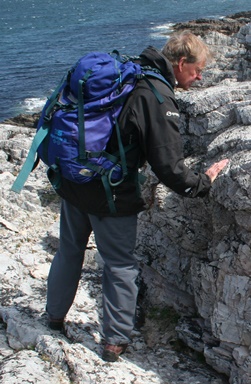Structural geologist with BGS who specialised in the geology of the NW Highlands and Islands of Scotland
 John was an active field and structural geologist who spent the greatest part of his career ranging widely, and with long strides, across the Highlands and Islands of Scotland as a geologist with the British Geological Survey (BGS). In many ways, he followed in the footsteps of geologists whom he greatly admired and whose Survey and academic careers he studied closely; Geikie, Peach and Horne, and Clough. Through his many seasons of mapping the Lewisian, Moine and Dalradian successions across Scotland, John achieved an encyclopaedic knowledge of these rocks and their geological evolution, a knowledge that he was happiest sharing with all who would spend time debating in the field with him, professional and amateur alike. John passed away on 8 December 2016.
John was an active field and structural geologist who spent the greatest part of his career ranging widely, and with long strides, across the Highlands and Islands of Scotland as a geologist with the British Geological Survey (BGS). In many ways, he followed in the footsteps of geologists whom he greatly admired and whose Survey and academic careers he studied closely; Geikie, Peach and Horne, and Clough. Through his many seasons of mapping the Lewisian, Moine and Dalradian successions across Scotland, John achieved an encyclopaedic knowledge of these rocks and their geological evolution, a knowledge that he was happiest sharing with all who would spend time debating in the field with him, professional and amateur alike. John passed away on 8 December 2016.
John was born on 10 January 1945, the middle child of three, on the outskirts of the expanding industrial town of Middlesbrough with farmland at the other end of the road. Family holidays that explored the mountainous regions of the Alps in the 1950s and 1960s established a pattern for John’s life in geology. After studying at Leeds University, where he met his wife Mary through the University Caving Club and from where he graduated in 1967 (BSc Geology), the couple travelled to Australia. John began work mapping for the Bureau of Mineral Resources in the Northern Territory (1967-1971).
Returning to the UK, John studied for the MSc in Structural Geology and Rock Mechanics at Imperial College, London (1972), and then moved to Edinburgh to undertake his Ph.D.. John’s research into the Structure & Metamorphism of the Tonale Pass area involved three seasons of detailed mapping in the mountains of Northern Italy. Edinburgh University awarded his PhD in 1976.
John had a very active career with BGS, starting in November 1974; he was always very directly involved in the detailed mapping of large tracts of the Outer Hebrides, Northern Highlands and Grampian Highlands of Scotland (sometimes with family in tow). A contemporary described John the field geologist as one who listened carefully to what the rocks had to say, and recorded it with care (and in faultless English); another that John seemed to have a special insight when he looked at the rocks and that his enthusiasm never waned. That was why he was always last to get back on the coach!
John led, contributed to, and participated in much of the modern published mapping output in the Highlands and Islands of Scotland by BGS, most notably completion of the NE Grampians mapping that delivered at least 16 1:50k map sheets between 1992 and 2002. In particular, John’s knowledge is the thread that runs throughout the Geological Conservation Review Series Volume 34 (2009), Lewisian, Torridonian and Moine Rocks of Scotland. Along with its companion volume for the Dalradian Rocks of Scotland (published as Vol. 124 of the Proceedings of the Geologists’ Association, 2013), these two volumes stand testament to John’s contribution to the geology of Scotland
Formal retirement in June 2006 came and went for John, as he continued as an Honorary Research Associate with BGS, seemingly always present as a respected mentor and sounding-board for all of his colleagues. Retirement did allow John to become a much sought-after excursion leader in the Highlands for a wide range of international groups and geological societies, especially but not exclusively the Edinburgh, Glasgow, and Open University geological societies. Though he never worked formally in academia John held his own with, and was greatly respected by, all who engaged with him, often the perfect bridge between the very different perspectives of geological survey and university research – and a bridge of immense benefit to both sides.
John’s active retirement (running, yoga, gardening and bridge are only part of a long list) did allow him time to further expand his knowledge and appreciation of the world’s wines. This was always to the fore in the field excursion dinners and evening discussions that John and his many contemporaries and fellow geologists shared, usually with a bottle or two.
John is survived by his three children Tom, Neil and Josephine and by his four grandchildren, Ben, Arun, Summer and Sam.
Graham Leslie